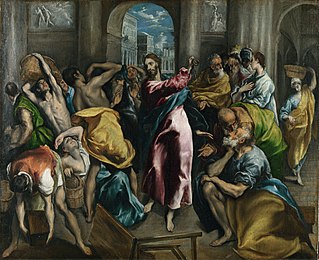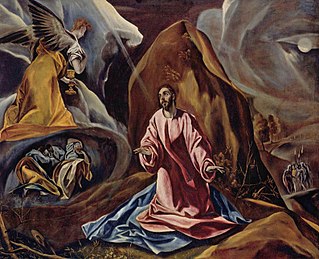
Domḗnikos Theotokópoulos, most widely known as El Greco, was a Greek painter, sculptor and architect of the Spanish Renaissance. El Greco was a nickname, and the artist normally signed his paintings with his full birth name in Greek letters, often adding the word Κρής, which means "Cretan".

El Greco painted his Dormition of the Virgin near the end of his Cretan period, probably before 1567. El Greco's signature on the base of the central candelabrum was discovered in 1983. The discovery of the Dormition led to the attribution of three other signed works of "Doménicos" to El Greco and then to the acceptance as authentic of more works, signed or not.

The Disrobing of Christ or El Expolio is a painting by El Greco begun in the summer of 1577 and completed in the spring of 1579 for the High Altar of the sacristy of the Cathedral of Toledo, where it still normally hangs. In late 2013 it was on temporary display at the Prado in Madrid, following a period of cleaning and conservation work there; it was returned to Toledo in 2014. It is one of El Greco's most famous works. A document dated July 2, 1577 which refers to this painting is the earliest record of El Greco's presence in Spain. The commission for the painting was secured thanks to El Greco's friendship from Rome with Luis, the son of Diego de Castilla, the dean of the Cathedral of Toledo. De Castilla senior also arranged El Greco's other major commission, on which he worked simultaneously, the paintings for the Toledan church of Santo Domingo el Antiguo.

Christ Driving the Money Changers from the Temple is a 1595-1600 Christian art painting by El Greco, now in the Frick Collection. It depicts the Cleansing of the Temple, an event in the Life of Christ.

Christ Driving the Money Changers from the Temple is a 1600 painting by El Greco, now in the National Gallery in London, England. It depicts the Cleansing of the Temple, an event in the Life of Christ.

Christ Driving the Money Changers from the Temple is a 1609 Christian art painting by El Greco, now in the church of San Ginés in Madrid. It depicts the Cleansing of the Temple, an event in the Life of Christ.

Christ Driving the Money Changers from the Temple is a painting by El Greco, from 1568, now in the National Gallery of Art in Washington, D.C., in the United States. It depicts the Cleansing of the Temple, an event in the Life of Christ.

Christ Driving the Money Changers from the Temple is a 1571 Christian art painting by El Greco, now in the Minneapolis Institute of Art. It depicts the Cleansing of the Temple, an event in the Life of Christ.

The El Greco Museum is located in Toledo, Spain. It celebrates the mannerist painter El Greco, who spent much of his life in Toledo, having been born in Fodele, Crete.

Concert of Angels is a work of El Greco in oil on canvas from 1608, during his last period in Toledo, Spain. It is exhibited at the National Gallery in Athens.
The Doña María de Aragón Altarpiece was an altarpiece painted between 1596 and 1599 by El Greco for the chapel of the Colegio de la Encarnación in Madrid. The college was secularised during Goya's lifetime and the altarpiece was dismantled. There has been much speculation over which paintings belonged to the work. The consensus view is that it consisted of six large canvases and a seventh, now lost. Five of those six canvases are now in the Prado and the sixth is in the National Museum of Art of Romania in Bucharest.

Agony in the Garden is a 1597-1607 oil on canvas painting by El Greco. It is now in Santa María la Mayor church in Andújar.

Agony in the Garden is a 1590 oil on canvas painting by El Greco or his studio, dating to his second stay in Toledo and still showing the major influence of Titian on his work. It is now on display in the Toledo Art Museum in Toledo, Ohio.

Holy Family is a 1586-1588 oil on canvas painting by El Greco, painted during his time in Toledo and now in that city's Museum of Santa Cruz.

Saint Peter is a 1608 oil on canvas painting produced by El Greco in Toledo towards the end of his life. It is now in the Monasterio del Escorial near Madrid.

Saint Anthony of Padua is a 1580 oil on canvas painting by El Greco, now in the Museo del Prado in Madrid.

Christ Carrying the Cross is a 1597–1600 painting by El Greco, belonging to the end of his life in Toledo. It is now in the Museo del Prado in Madrid.

Christ Carrying the Cross is an oil painting by El Greco, produced early in his Toledo period circa de 1580. The picture depicts Christ in a moment of personal reflection as he carries the cross to his death, therefore committing the ultimate sacrifice for humankind. In the painting, Christ's eyes are lifted up to the heavens as he begins his walk towards his crucifixion. His gentle hands wrap around the cross as a stormy night floods the background. Christ Carrying the Cross is an oil painting, 105x79cm. The painting, one of numerous similar paintings by El Greco, is currently in the El Greco room in the New York art collection of the Metropolitan Museum of Art.

Holy Face of Jesus is a 1586–1595 painting by El Greco of the Holy Face of Jesus on a veil. It is now in the Museo del Prado, in Madrid, which acquired it in 1944 using funds from a legacy from the conde de Cartagena.

Christ Taking Leave of his Mother is a 1595 oil on canvas painting by a Greek artist Theotokopoulos Domenikos, better known as El Greco. The painting represents the first depiction of the subject by the artist.



















